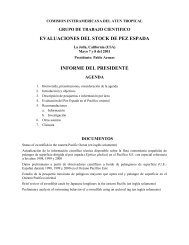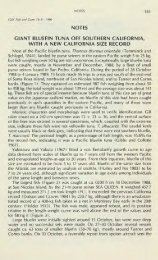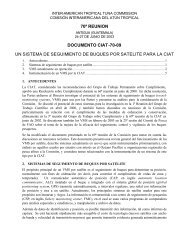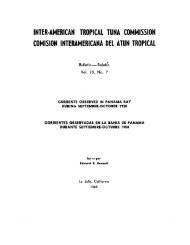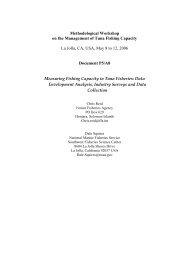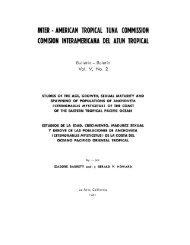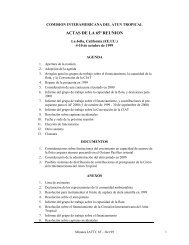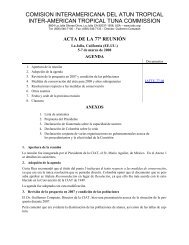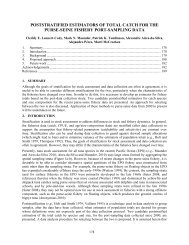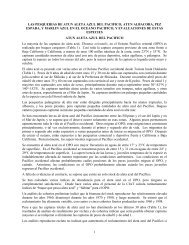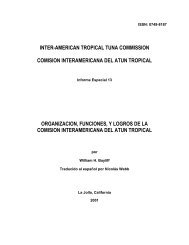Informe Anual de la Comisión Interamericana del Atún Tropical, 19
Informe Anual de la Comisión Interamericana del Atún Tropical, 19
Informe Anual de la Comisión Interamericana del Atún Tropical, 19
You also want an ePaper? Increase the reach of your titles
YUMPU automatically turns print PDFs into web optimized ePapers that Google loves.
22 TUNA COMMISSION<br />
otolith primordium, or point of original growth, to the mark, and from the mark to the edge of the<br />
otolith, the lengths at tagging and at recapture can be estimated from a growth curve re<strong>la</strong>ting the<br />
otolith length to the length ofthe fish. For each fish, the corresponding values of otolith growth rate<br />
(G o ) and G i can be estimated from these measurements. The benefits of estimating growth rates of<br />
the fish by this procedure are: (l) errors associated with measuring live fish are avoi<strong>de</strong>d, (2) the<br />
values of G i are based on a consistent standard of measurement (frozen and thawed fish) via the<br />
otolith length-fish length re<strong>la</strong>tionship, and (3) all values of G i are obliged to positive because G o<br />
cannot be negative. Un<strong>de</strong>r these conditions, the variance of G i should be smaller and more reliable<br />
than the corresponding variance of G t prepared from tagging data. This statement is supported by<br />
comparisons <strong>de</strong>rived from the <strong>19</strong>76 and <strong>19</strong>80-<strong>19</strong>81 experiments listed in Table 15. Negative values of<br />
G t are not inclu<strong>de</strong>d in this tableo<br />
Eastern Pacific skipjack<br />
In contrast to the daily <strong>de</strong>position rate ofincrements in yellowfin, the <strong>19</strong>76 experiment showed<br />
that skipjack <strong>de</strong>posited, on the average, only 0.76 lid. Originally it was thought that this <strong>de</strong>parture<br />
from what was expected may have been due to the onset ofmaturity ofthe females, and to explore this<br />
possibility further the sexes ofthe fish recovered from the <strong>19</strong>80-<strong>19</strong>81 experiments were i<strong>de</strong>ntified by<br />
gross examination oftheir gonads. Apreliminary analysis indicates that the <strong>de</strong>position rates for the<br />
sexes are simi<strong>la</strong>r and stillless than 1lid, i.e., males: 0.73 lid (n = 14); females: 0.70 lid (n = 23).<br />
These rates are based on the maximum increment count obtained from three different counting<br />
positions. Initially, the counts were ma<strong>de</strong> on the distal surfaces ofthe anterior otolith projections, as<br />
in the <strong>19</strong>76 experimento Subsequently counts were also obtained from the distal surface of<br />
projections in the ventral-anterior quadrant, and from both surfaces of the centrally-Iocated<br />
posterior projections. Frequently, the counts from these three positions did not agree, and the<br />
possibility exists that sorne increments may be too small to discern with a light microscope (1200x).<br />
Otolith sections are therefore being prepared for examination at increased levels of magnification,<br />
using a scanning electron microscope.<br />
Eastern At<strong>la</strong>ntic yellowfin<br />
The experience gained in i<strong>de</strong>ntifying and counting increments in the aboye experiments was<br />
applied to a small sample of otoliths from eastern At<strong>la</strong>ntic yellowfin. The fish were injected and<br />
recaptured during <strong>19</strong>79-<strong>19</strong>83, and their otoliths were sent to the Commission by the Centre <strong>de</strong><br />
Recherches Océanographiques, Abidjan, Ivory Coast. The number ofincrements from the mark to<br />
the otolith edge could be counted reliably on only five fish. In the re<strong>la</strong>tionship between increments<br />
and time, i.e.,<br />
1 = - 6.95 + 1.05d (n = 5)<br />
The coefficient 1.05 ( ±: 0.15) does not differ significantly from 1.0. Therefore, yellowfin in the eastern<br />
At<strong>la</strong>ntic may also <strong>de</strong>posit increments daily, or at least the sample size is too small to reject this<br />
hypothesis. This result is encouraging, <strong>de</strong>spite the small sample size.<br />
Reproductive biology ofyellowfin<br />
Knowledge ofthe reproductive biology ofyellowfin tuna is important for un<strong>de</strong>rstanding ofthe<br />
popu<strong>la</strong>tion dynamics of this species. Various aspects of the reproductive biology of yellowfin,<br />
including locations and times of spawning, size and age at maturity, and spawning frequency, are<br />
still not well un<strong>de</strong>rstood. There is also a need to <strong>de</strong>termine whether there is diversity with respect to<br />
reproductive characteristics of fish in different parts of the eastern Pacifico Research on yellowfin<br />
reproductive biology should contribute to an un<strong>de</strong>rstanding of the link between spawning and<br />
recruitment and make it possible to evaluate the effect offishing on the reproductive potential ofthe<br />
popu<strong>la</strong>tíon.



